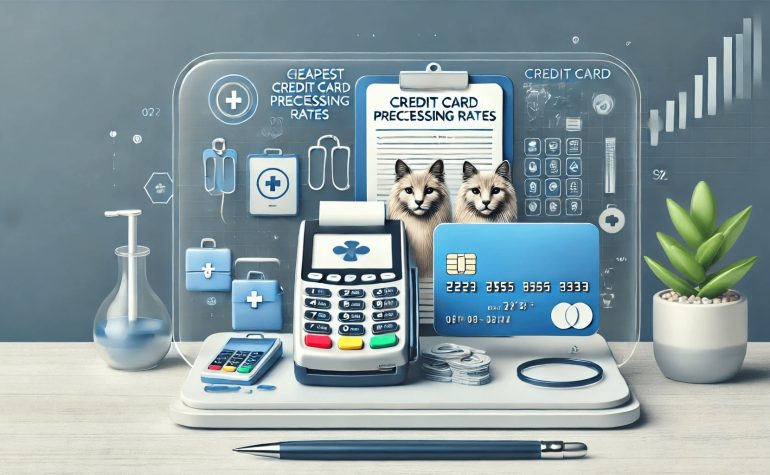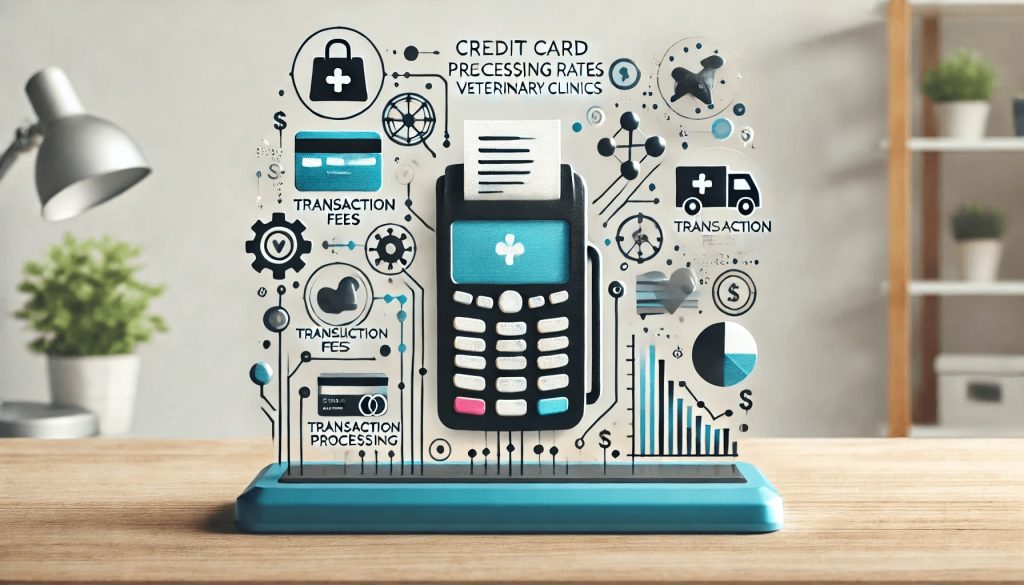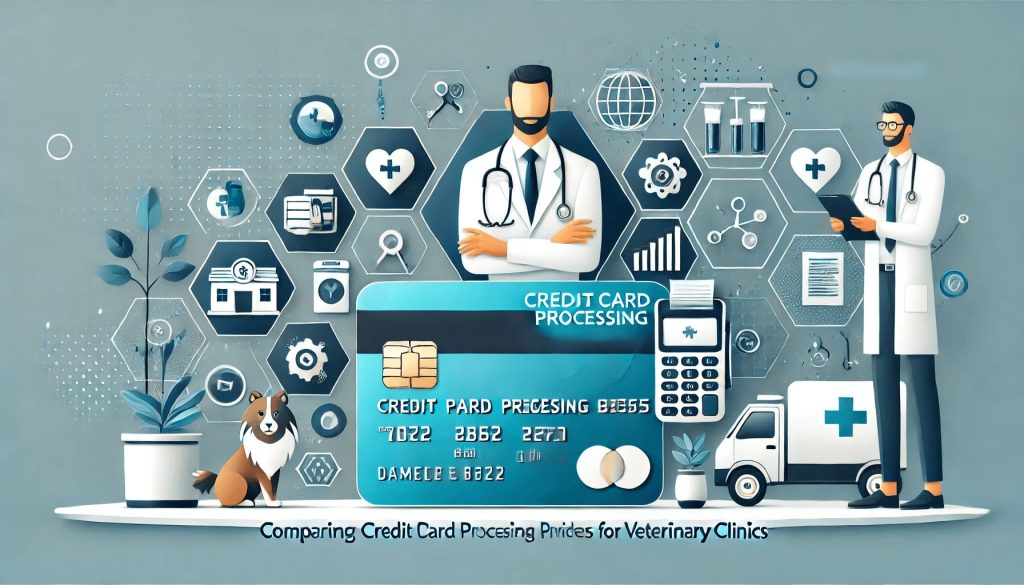
By alphacardprocess October 5, 2024
In today’s digital age, credit card processing has become an essential part of running a successful business, including veterinary clinics. The ability to accept credit card payments not only provides convenience for clients but also increases revenue and streamlines financial transactions.
However, credit card processing fees can quickly add up, eating into the clinic’s profits. Therefore, it is crucial for veterinary clinics to find ways to get the cheapest credit card processing rates without compromising on the quality of service. This article will explore various strategies and tips to help veterinary clinics obtain affordable credit card processing rates.
Factors Affecting Credit Card Processing Rates for Veterinary Clinics

Before diving into the strategies, it is essential to understand the factors that influence credit card processing rates for veterinary clinics. Several key factors determine the cost of credit card processing, including:
- Business Type: Veterinary clinics fall under the category of “high-risk” businesses due to the potential for chargebacks and disputes. This classification often leads to higher processing rates.
- Transaction Volume: The number of credit card transactions processed by the clinic plays a significant role in determining the processing rates. Higher transaction volumes can often lead to lower rates.
- Average Transaction Size: The average amount of each transaction can impact the processing rates. Smaller transactions may result in higher rates, while larger transactions may qualify for lower rates.
- Payment Methods: The types of payment methods accepted by the clinic can affect the processing rates. Accepting only credit cards may result in higher rates compared to clinics that also accept debit cards or mobile payments.
- Credit Card Processing Provider: The credit card processing provider chosen by the veterinary clinic plays a crucial role in determining the rates. Different providers offer varying fee structures and pricing models.
Researching and Comparing Credit Card Processing Providers for Veterinary Clinics

To get the cheapest credit card processing rates, veterinary clinics must conduct thorough research and compare different credit card processing providers. Here are some steps to follow:
- Identify Clinic’s Needs: Before starting the research, it is essential to identify the specific needs of the veterinary clinic. Consider factors such as transaction volume, average transaction size, and preferred payment methods.
- Research Providers: Look for credit card processing providers that specialize in serving veterinary clinics or high-risk businesses. Read reviews, check their reputation, and compare their pricing structures.
- Compare Pricing Models: Different credit card processing providers offer various pricing models, such as interchange-plus pricing or flat-rate pricing. Understand the pros and cons of each model and choose the one that aligns with the clinic’s needs.
- Analyze Fee Structures: Carefully review the fee structures of different providers. Look for hidden fees, such as monthly minimums, statement fees, or PCI compliance fees. Ensure that the provider offers transparent pricing.
- Consider Value-Added Services: Some credit card processing providers offer additional services, such as online payment gateways, virtual terminals, or recurring billing options. Evaluate these services and determine if they add value to the clinic’s operations.
- Seek Recommendations: Reach out to other veterinary clinics or industry professionals for recommendations on credit card processing providers. Their experiences and insights can help narrow down the options.
Negotiating with Credit Card Processing Providers for Veterinary Clinics
Once a veterinary clinic has identified potential credit card processing providers, it is time to negotiate for the best rates. Negotiating can be intimidating, but it is an essential step to secure affordable credit card processing rates. Here are some tips for effective negotiation:
- Understand the Market: Research the current market rates for credit card processing in the veterinary industry. This knowledge will give the clinic leverage during negotiations and prevent overpaying.
- Highlight Clinic’s Strengths: Emphasize the clinic’s positive attributes, such as a loyal customer base, high transaction volume, or low chargeback rates. These strengths can be used as bargaining chips to negotiate lower rates.
- Request Multiple Quotes: Obtain quotes from multiple credit card processing providers and use them as leverage during negotiations. Providers may be willing to match or beat their competitors’ rates to win the clinic’s business.
- Negotiate Contract Terms: In addition to rates, negotiate favorable contract terms, such as the length of the agreement, termination fees, or equipment costs. Flexibility in these areas can lead to cost savings in the long run.
- Consider Bundled Services: Some credit card processing providers offer bundled services, such as payment gateways or point-of-sale systems, at discounted rates. Explore these options and negotiate for bundled services to save on overall costs.
Implementing Cost-Saving Strategies for Credit Card Processing in Veterinary Clinics
In addition to negotiating with credit card processing providers, veterinary clinics can implement various cost-saving strategies to reduce credit card processing fees. Here are some effective strategies to consider:
- Invest in EMV Technology: EMV chip technology provides an added layer of security and can help reduce the risk of fraudulent transactions. By investing in EMV-enabled terminals, veterinary clinics may qualify for lower processing rates.
- Optimize Payment Processing Equipment: Regularly review and update payment processing equipment to ensure efficiency and compatibility with the latest technology. Outdated equipment may result in higher processing rates.
- Train Staff on Best Practices: Educate clinic staff on best practices for credit card processing, such as obtaining proper authorization, verifying identification, and securely handling customer data. By reducing errors and chargebacks, clinics can potentially lower processing rates.
- Monitor and Analyze Statements: Regularly review credit card processing statements to identify any unnecessary fees or discrepancies. Analyze transaction data to identify patterns and potential areas for cost savings.
- Utilize Address Verification System (AVS): AVS is a fraud prevention tool that verifies the billing address provided by the cardholder. By utilizing AVS, veterinary clinics can reduce the risk of fraudulent transactions and potentially qualify for lower processing rates.
Understanding the Different Types of Credit Card Processing Fees for Veterinary Clinics

To effectively manage credit card processing costs, veterinary clinics must understand the different types of fees associated with credit card processing. Here are the most common fees to be aware of:
- Interchange Fees: Interchange fees are charged by the card-issuing bank and vary based on factors such as card type, transaction type, and risk level. These fees are non-negotiable and typically make up a significant portion of the processing costs.
- Assessment Fees: Assessment fees are charged by the card networks, such as Visa or Mastercard, and are also non-negotiable. These fees are typically a percentage of the transaction volume and vary based on the card network.
- Markup Fees: Markup fees are the fees charged by the credit card processing provider for their services. These fees are negotiable and can vary significantly between providers. Markup fees can be charged as a percentage of the transaction or as a flat rate.
- Monthly Fees: Monthly fees, such as statement fees or account maintenance fees, are charged by the credit card processing provider for maintaining the account. These fees can vary between providers and should be carefully reviewed before signing a contract.
- Chargeback Fees: Chargeback fees are incurred when a customer disputes a transaction and the funds are returned to the customer. These fees can be significant and should be minimized by implementing fraud prevention measures and providing excellent customer service.
Tips for Reducing Credit Card Fraud and Chargebacks in Veterinary Clinics

Credit card fraud and chargebacks can significantly impact the profitability of veterinary clinics. Implementing strategies to reduce fraud and chargebacks is crucial for maintaining affordable credit card processing rates. Here are some tips to consider:
- Verify Cardholder Information: Ensure that the cardholder’s information, such as the billing address and CVV code, matches the information provided during the transaction. This verification process can help prevent fraudulent transactions.
- Implement EMV Chip Technology: EMV chip technology provides an added layer of security by encrypting transaction data. By accepting EMV chip cards and utilizing EMV-enabled terminals, veterinary clinics can reduce the risk of fraudulent transactions.
- Train Staff on Fraud Prevention: Educate clinic staff on common signs of fraudulent transactions and best practices for preventing fraud. Staff should be vigilant in identifying suspicious behavior and verifying customer information.
- Utilize Address Verification System (AVS): AVS is a fraud prevention tool that verifies the billing address provided by the cardholder. By utilizing AVS, veterinary clinics can reduce the risk of fraudulent transactions and potential chargebacks.
- Provide Excellent Customer Service: By providing exceptional customer service, veterinary clinics can build trust with their clients and reduce the likelihood of chargebacks. Promptly address customer concerns and resolve any issues to prevent disputes.
Exploring Alternative Payment Options for Veterinary Clinics
While credit card processing is essential for veterinary clinics, exploring alternative payment options can provide additional flexibility and potentially reduce processing costs. Here are some alternative payment options to consider:
- Debit Cards: Accepting debit cards can be a cost-effective alternative to credit cards, as debit card transactions often have lower processing fees. Encourage clients to use their debit cards for payments whenever possible.
- Mobile Payments: Mobile payment options, such as Apple Pay or Google Pay, are becoming increasingly popular. These payment methods utilize near-field communication (NFC) technology and can provide a convenient and secure payment option for clients.
- Electronic Funds Transfer (EFT): EFT allows clients to make payments directly from their bank accounts. By offering EFT as a payment option, veterinary clinics can avoid credit card processing fees altogether.
- Payment Plans: Consider offering payment plans or financing options for clients who may struggle to pay for veterinary services upfront. Partnering with third-party financing companies can provide a convenient solution for clients while reducing the clinic’s financial risk.
Frequently Asked Questions (FAQs)
Q.1: How can veterinary clinics find the cheapest credit card processing rates?
Veterinary clinics can find the cheapest credit card processing rates by researching and comparing different providers, negotiating for lower rates, and implementing cost-saving strategies.
Q.2: What factors affect credit card processing rates for veterinary clinics?
Factors such as business type, transaction volume, average transaction size, payment methods, and the chosen credit card processing provider can influence the rates.
Q.3: How can veterinary clinics reduce credit card fraud and chargebacks?
Veterinary clinics can reduce credit card fraud and chargebacks by verifying cardholder information, implementing EMV chip technology, training staff on fraud prevention, utilizing AVS, and providing excellent customer service.
Q.4: What are some alternative payment options for veterinary clinics?
Alternative payment options for veterinary clinics include accepting debit cards, offering mobile payment options, utilizing electronic funds transfer, and providing payment plans or financing options.
Conclusion
Affordable credit card processing rates are crucial for veterinary clinics to maximize revenue and streamline financial transactions. By understanding the factors that affect credit card processing rates, researching and comparing providers, negotiating for lower rates, implementing cost-saving strategies, and exploring alternative payment options, veterinary clinics can achieve the cheapest credit card processing rates without compromising on the quality of service.
It is essential for veterinary clinics to regularly review their credit card processing fees, stay informed about industry trends, and adapt their strategies to ensure ongoing cost savings. With careful planning and proactive measures, veterinary clinics can optimize their credit card processing and enhance their financial stability.